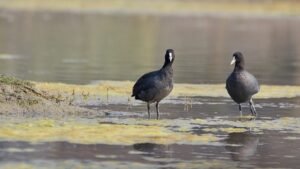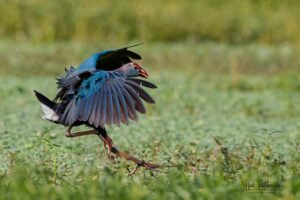Read in : தமிழ்
With the onset of summer, the birding season is slowly coming to an end. Bird watchers have been busy spotting their favourite birds in the wetlands of Tamil Nadu and capturing them on their cameras. The Tamil Nadu Forest Department is to undertake their annual bird counting exercise shortly. As the season draws to a close, what have they observed?
Ornithologists say that the numbers of certain species such as glossy ibis, black headed ibis, grey headed swamp hens, and common coots are steadily rising while some species that were used to be found in good numbers are decreasing. What does this imply?
According to ornithologists and environmentalists, the kind of birds our wetlands attract are indicators of the environment. The increased presence of ibis, coots and swamp hens means just one thing: Our water bodies are getting contaminated with sewage waste. Ornithologists say these species thrive on sewage water. The biological content in the sewage provides them sufficient prey and nutrients.

These common coots were photographed at Keoladeo National Park, Bharatpur, Rajasthan in February 2020, but they are common now in Tamil Nadu’s murky wetlands as well (Wikimedia Commons – Nagarjun)
Till the 1990s, it was uncommon to spot a glossy ibis in water bodies down south, says M Mathivanan from Agasthyamalai Community-based Conservation Centre of ATREE (Ashoka Trust for Research in Ecology & The Environment). The centre conducts the Tamirabharani Waterbird Census every year. “Glossy ibis used to be found in the North. But people come to the South to see them now. They are widespread now,” he says.
With abundant prey and a conducive habitat of sewage mixed water bodies, the glossy ibis has become a resident bird of south Tamil Nadu. It is no more a migrant from North India, which was the case two decades earlier. “Intriguingly, the white egrets which used to thrive in good water tanks have declined. They are mostly found in estuaries near the coastline now,” says environmentalist N Raveendran. He is actively involved in documenting wildlife, especially bird species across Tamil Nadu.
With abundant prey and a conducive habitat of sewage infested water bodies, glossy ibis has become a resident bird of South Tamil Nadu. It is no more a migrant from North India, which was the case two decades earlier. “Intriguingly, the white egrets which used to thrive in good water tanks have declined. They are now mostly found in estuaries near the coastline now,” says environmentalist N Raveendran.
Raveendran feels that like glossy ibis, another species—the common coots—are also thriving in the wetlands of Tamil Nadu. Like ibis, coots also prefer sewage contaminated water bodies. “Our wetlands are getting contaminated by the indiscriminate release of untreated sewage water. Birds are the indicators of our environment,” he says.
The Tamil Nadu State Wetland Authority has documented 24,684 wetlands with an estimated area of 9,02,534 hectares. The inland wetlands are 24,089 with an area of 7,61,867 while the coastal wetlands are 595 with an estimated area of 1,22,373 hectares. Environmentalists say that the wetlands, especially near the city areas, are always under the threat of sewage contamination.

A large number of grey headed swamp hens make a dirty swampy lake their home for the summer. They are occasionally involved in fights with their own flock or with the jacanas. They are able to take off only for short distances. (Wikimedia Commons – Hari K Patibanda)
Madurai based ornithologist Dr T Badri Narayanan says grey headed swamp hens are also spotted in significant numbers. These birds thrive on floating water plants, especially water hyacinth. With slender legs, these birds walk on these water plants to find their prey.
Water hyacinths are dangerous invasive weeds native to the Amazon forests. Outside their natural habitat, this water plant is very destructive as it can drain oxygen from water bodies and kill the fish stock. It is fittingly called Bengal Terror or Blue Devil. A water body infested with water hyacinth loses its aquatic life very soon and the water turns murkier as hyacinths stop sunlight penetrating into the water.
Madurai based ornithologist Dr T Badri Narayanan common pochards, a diving duck species, which was abundant in the water bodies once have become a rarity. Unlike other duck species like garganey ducks, bar-headed geese and pintail ducks, pochards need deeper water bodies to find their prey. “It indicates that our water bodies need proper desilting. They have become shallow to a point of not supporting these diving ducks,” he says.
Badri Narayanan also pointed out that the common pochards, a diving duck species, which was abundant in the water bodies once have become a rarity. Unlike other duck species like garganey ducks, bar-headed geese and pintail ducks, these birds need deeper water bodies to find their prey. “It indicates that our water bodies need proper desilting. They have become shallow to a point of not supporting these diving ducks,” he says. He also adds that glossy ibis which were rare once in Tamil Nadu are found across the state now.
The environmentalists feel that the state government should act on these indicators. We can’t blame the ibis or swamp hens because they are thriving where they find nutrients and prey. An ecosystem should have both good and murky wetlands to support all types of bird species. The skewed number of these kinds of bird species should sound alarm bells that lead to corrective measures to protect the environment.
But the government agencies themselves are heavy polluters and encroachers of habitat. A good number of government projects and housing boards are sitting on silted water bodies. “Ironically, the courts which should stop this encroachment are also situated on silted lakes and ponds,” adds Raveendran.
Read in : தமிழ்











